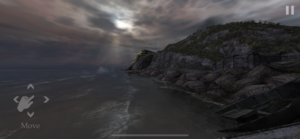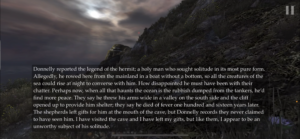For my critical play, I played the game Dear Esther created by The Chinese Room and Robert Briscoe. During my couple hours of play throughout the week, I found that I was truly immersed in an experience I had never had playing games. Dear Esther does not have challenges, puzzles, or violence among other elements common in many games I have played; however, despite it lacking details that make a video game feel familiar to me, I found myself enjoying this experiment in storytelling through the video game medium.
Formal Elements of Dear Esther
Player & Roles:
There were no other players but myself, the point-of-view character, and then an omniscient narrator. It did not seem that I had extra powers of any kind to indicate I had a special role of any kind other than a walking main character. Interestingly, the narrator usually, if not always, spoke only when I would be walking, which indicates that my character and their movements are tied to the narrator’s existence/actions in the game.

Outcome & Objective
The outcome of this game is not necessarily zero-sum or non-zero-sum in nature since there is no winning and losing party; however, if push came to shove, I would assume this game is a non-zero-sum type of game. I don’t have an antagonist in the game and there isn’t infrastructure in place to “beat” someone or “win” in challenges, therefore losing also is not an option.
In terms of winning, although, as mentioned above, there isn’t explicit chances to win something, I can assume that “success” in the game means pursuing paths within the multiple locations in the game and reaching the end of those paths. Fully exploring the paths offered seems to be a form of winning since this game is so heavily embedded in the action of simply walking and exploring; by exploring a path in depth, I am fulfilling my character’s purpose in the game.
Rules & Procedures
In this game, since there aren’t really challenges to overcome but rather a mission to explore, the rules felt less like rules of a game and more laws of physics at play: you either move where the game permits (i.e. cannot fly up a hill magically) or you run into spots where you cannot walk such as facing a wall (you cannot walk through walls) and must navigate around those areas.
In terms of procedures or how the rules manifest in the gameplay, one could notice quickly that a ‘ghost rule’ is that in order to progress through the story, one must walk around and discover clues or narrative snippets to piece together the story. I say ‘ghost rule’ because it’s not explicitly known that one must walk to progress in the game; it’s just implied. This dynamic is very similar to how Dan Cook noted in his piece about interaction loops: walking and noticing that one must investigate landmarks by walking is an interaction loop. It’s a skill the user must learn to play the game. Then, discovering snippets becomes a consequence of the loop.
Resources & Boundaries
For resources, the primary one would be the directions or insights given by the narrator. Furthermore, there are pop up messages from my character offer help in piecing together the storyline. More importantly, the directions or narrator’s comments are driven by me walking around, indicating that walking is critical to story development.
In terms of boundaries, I am bound by the confines of the island itself and there seem to be boundaries or un-walkable areas within the island as well, but they are not brightly highlighted within the game as being un-walkable. This led to me running into prohibited areas without realizing I had approached them in the first place.
If a player does indeed ‘drown,’ the game restarts where you are on land. Below is a picture of when I ran into the ocean to test the boundaries. It sort of turns black but you can see slight waves washing over your eyes.

Type of Fun:
If this game were a car, the gasoline to power the car would be the walking element and the car itself would be the storyline. The walking component of the game pushes the player to investigate landmarks and hear more anecdotes and pieces of the storyline from the narrator. This indicates to me that this game is situated in the “discovery” type of fun. Moreover, because we are walking around to learn more about the storyline, there seems to be a narrative component to the fun of this game. Therefore, I would definitely say that this game is 85% discovery and 15% narrative, if I had to give my opinion in a quantitative way.
Below is a photo of when I was walking around and the narrator would suddenly introduce new bits of information, highlighting how this game progress normally.

Feedback
Although an unsolicited portion of this assignment, I feel that this game severely lacks in user controls for the IOS platform. The narrator speaks painfully slow, especially when I would like to get started with the game. Furthermore, when the narrator is speaking, it seems my controls are locked sometimes, so I can move but my viewpoint doesn’t change i.e. my gaze cannot be changed. This makes it basically futile to continue playing while the narrator is speaking. If the game offered the option to skip/dismiss dialog or speed it up, that would be great, especially since not all dialog is integral to the story progression or for telling me where to go.



